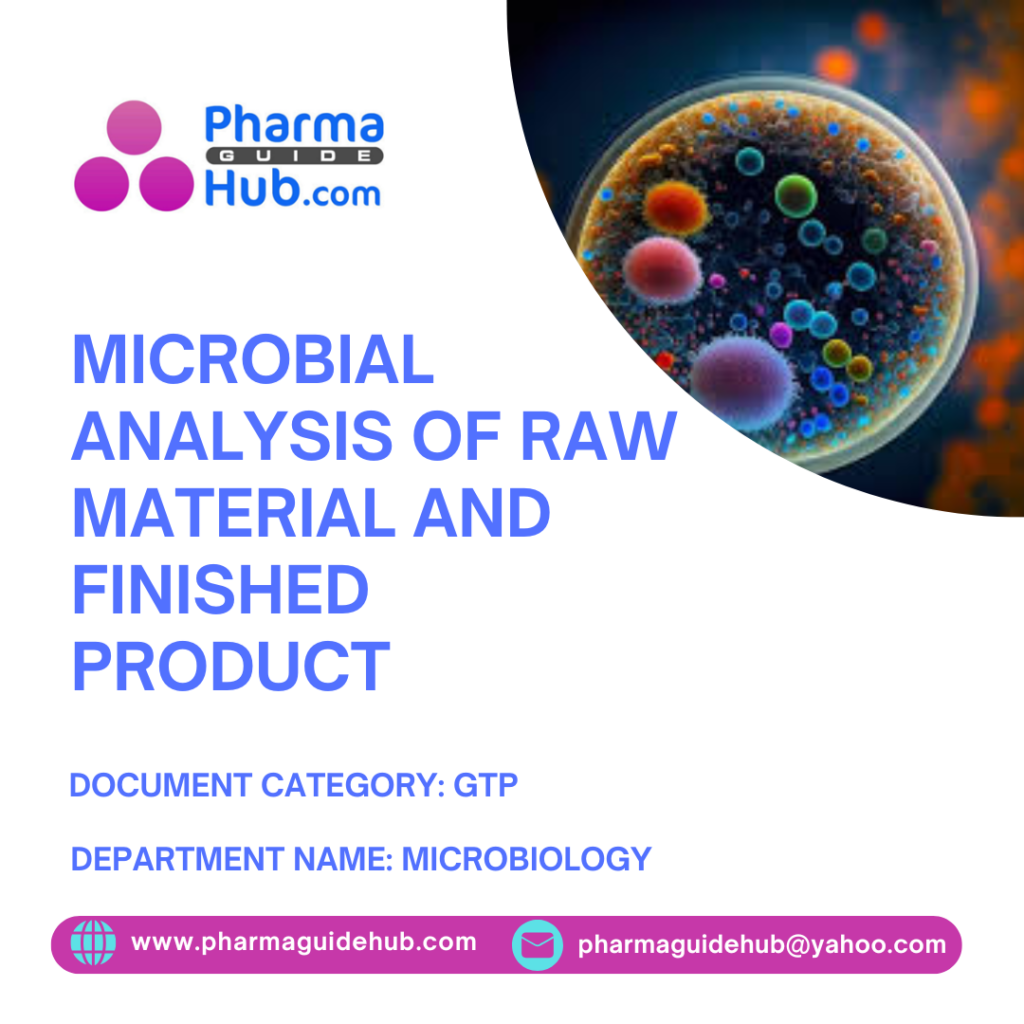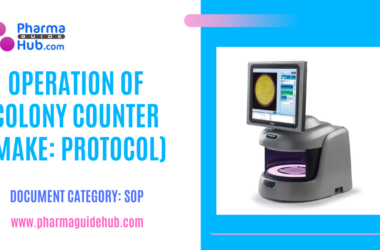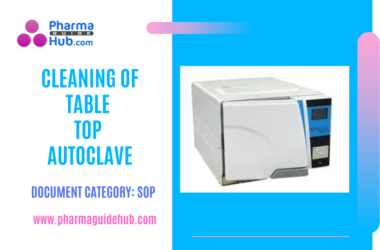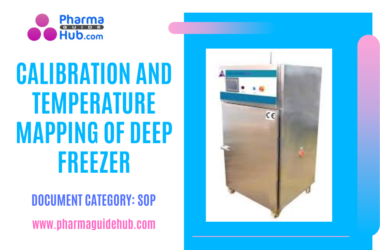
Scope:
The objective of Microbial Analysis of Raw Material and Finish Product is to provide sufficient information about the microbiological quality of the sample. The monitoring program and methodology should be able to detect adverse trends and detect microorganisms that are potentially harmful to the sample.
Requirements:
- Micropipette
- 70% IPA
- Colony counter
- Sterile Micropipette Tips
- Balance
- LAF
- Incubators Sterile Petri plates (90 mm)
Media Requirement:
- Buffered Sodium Chloride-Peptone Solution pH 7.0, Phosphate Buffer Solution pH 7.2.
- Soyabean Casein Digest Medium
- Soyabean Casein Digest Agar
- Sabouraud Dextrose Agar
- MacConkey Agar
- MacConkey Broth
- Rappaport Vassiliadis Salmonella Enrichment Broth
- Xylose Lysine Deoxycholate Agar
- EMB Agar
- Triple Sugar Iron Agar
- Mannitol salt agar
- Cetrimide Agar
- N,N,N′,N′-tetramethyl-p-phenylenediamine (TMPD) or N,N-dimethyl-p-phenylenediamine (DMPD) 2% -6 % H2O2
Required Test Reagent
Kovac’s Reagent
Procedure
Microbial Enumeration Test
By Pour Plate Method:
Enrichment Culture –A: Take 10 gm Sample, dissolved in 90 ml of soybean casein digest medium or buffered sodium chloride peptone solution pH 7.0, add 0.1%w/v of polysorbate 80 if necessary and adjust the volume to 100 ml with the same solution, Homogenize and vortex.
Total Aerobic Microbial Count: (TAMC)
Pipette out 1ml sample into each of two sterile 90 mm diameter petri dish, add 15 to 20 ml of Soyabean Casein Digest Agar Medium that is previously melted and cooled to around 45° C. Cover the Petri dishes and mix the sample with agar by tilting or rotating the Petri dishes. Allow to solidify at room temperature. Invert the Petri plates and incubate the plates at 30°C to 35°C for 3-5 days. Examine the plates for growth, count the number of colonies and express the average for 2 plates. Calculate the CFU’s per gram of original specimen
Total Bacterial count cfu/gm =Avg. No. of colony × dilution Factor / Volume of sample
Negative control: For negative control carry out the same procedure except for sample use 1.0 ml of sterile WFI. Invert and incubate all the plates at 30 to 350C for 5 days.
Positive control: GPT of the SCDA will be considering as a positive control.
Total Moulds and Yeasts Count (TYMC):
Pipette out 1ml sample into each of two sterile 90 mm diameter petri dish, Add 15 to 20 ml of Sabouraud Dextrose Agar that is previously melted and cooled to around 45° C. Cover the Petri dishes and mix the sample with agar by tilting or rotating the Petri dishes. Allow to solidify at room temperature. Invert the Petri plates and incubate the plates at 20°C to 25°C for 5-7 days. Examine the plates for growth, count the number of colonies and express the average for 2 plates. Calculate the CFU’s per gram or ml of original specimen.
Total Molds and Yeasts Count cfu/gm =Avg. No. of colony × Factor dilution / Volume of sample
Negative control: For negative control carry out the same procedure except for sample use 1.0 ml of sterile WFI. Invert and incubate all the plates at 20 to 250C for 5-7 days.
Positive control: GPT of the SDA will be considering as a positive control.
TEST FOR PATHOGENS
Test for specified microorganism.
Carry out testing for pathogen as follows:
Enrichment Culture – B: Add 10 gm or 1 gm Sample in to 90 ml or 99 ml of presterilized soybean casein digest medium adjust the volume to 100 ml with the same solution and mix. Incubate at 30-35°C for 18 – 24 hours.
Test for Escherichia coli
Selection and subculture: After incubation shake the tube (Enrichment Culture – B) then transfer 1 ml of enrichment culture B in to 10 ml of MacConkey broth, mix and incubate at 42-44°C for 24-48 hrs. Examine the media for acid and gas production. If acid or gas is produced, then aseptically streak a loopful from MCB on a plate of MacConkey agar and incubate the plate at 30-35°C for 18-24 hrs.
Interpretation: Growth of colonies (Brick red colonies may be surrounded by precipitated bile) Indicates the possible presence of E.coli.
This shall be confirmed by identification tests the product complies with the test if no colonies are present or if the identification test is negative.
Identification Tests
Indole Test
Reagents
1% Peptone broth
Kovac’s Reagent
Procedure :Take one loopful culture From MCA plates and transfer in to the 10 ml peptone broth and incubate at 370 C for 24 to 48 hours. Add 0.5 ml Kovac’s reagent and gently agitate. Examine the upper layer of the liquid. Perform positive control by inoculating E.coli (Indole positive)
Results
Positive result: Red color ring formation occurs within few seconds at the top of medium.
Negative result : yellow color
EMB agar for E.coli Detection
Streak the suspect colonies individually on the Levine EMB agar and incubate at 18-48 hrs at 30 to 350C. Examine the Metallic sheen observed under reflected light and Blue –Black appearance under transmitted light. Confirms the presence of E. coli.
Gram staining : Gram Negative
Test for Salmonella spp.
Selection and subculture: Transfer 0.1 ml of enrichment culture B in to 10 ml of Rappaport Vassiliadis salmonella enrichment broth and incubate at 30-35°C for 24-48 hrs. After incubation subculture on plates of Xylose lysine deoxycholate agar. Incubate at 30-35°C for 24-48 hrs.
Interpretation: The possible presence of Salmonella is indicated by the growth of well enveloped, red colonies, with or without black center.
This shall be confirmed by identification tests The product complies with the test, if colonies of the types described are not present or if the confirmatory identification tests are negative.
IDENTIFICATION TESTS
Reagents
Triple Sugar iron agar for Stab preparation
Procedure
Streak on Triple Sugar Iron Agar from XLDA media, first in the slant and then stabbing the wire well beneath the surface and incubate it at 30-350C for 18-48 hrs.
Results
- An alkaline/acid (red slant/yellow butt) reaction: It is indicative of dextrose fermentation only.
- An acid/acid (yellow slant/yellow butt) reaction: It indicates the fermentation of dextrose, lactose and/or sucrose.
- An alkaline/alkaline (red slant, red butt) reaction: Absence of carbohydrate fermentation results.
- Blackening of the medium: Occurs in the presence of H2S
- Gas production: Bubbles or cracks in the agar indicate the production of gas ( formation of CO2 and H2 S)
Alkaline (red) slants and Acidic (Yellow) butt with or without H2S production (Black color development).
Subculture on the plate of Bismuth sulphite Agar Incubate at 30-35℃ for 24-48 hours. Well-developed colorless colony observed .
Gram Staining : Gram Negative
Test for Pseudomonas aeruginosa
Examine the soyabean casein digest broth medium and Subculture on the plate of Cetrimide agar medium. Incubate the plates at 30-35°C for 18-72 hrs.
If upon examination, none of the plates contains colonies having the characteristics Greenish colony with greenish fluorescence for the media used, the sample meets the requirement for freedom from Pseudomonas aeruginosa.
Pigment Production:
With the aid of inoculating loop streak representative suspected colonies from the surface of Cetrimide agar medium to the agar surface of Pseudomonas medium for detection for fluorescence containing Pyocyanin. If numerous colonies are to be transferred, divide the surface of each plate into quadrants each which may be inoculated from a separate colony. Cover and invert the inoculated plate, and incubate at 300C-350C for not less than three days. Examine the streaked surface under ultraviolet light for the production of yellowish fluorescence by the bacterial colonies. Confirm any suspected colonial growth by means of the oxidase test.
Oxidase test:
Transfer the colony from the CA medium to disc that previously impregnated with 1 % N, N- Tetramethyl-p-phenylenediamine dihydrochloride. If the disc color is changed (from white to purple or blue color) within five to ten seconds it confirms the presence ofPseudomonas aeruginosa.
Result :
Positive Result: disc color is changed from white to purple or blue color indicates oxidase production.
Negative Result: No blue color
Gram Staining : Gram Negative
Test for Staphylococcus aureus
Selection and subculture: Subculture on the plate of Mannitol salt agar & Incubate at 30-35°C For 18-72 hours.
Interpretation: The possible presence of S.aureus is indicated by the growth of yellow/white colonies surrounded by a yellow zone. This shall be confirmed by identification tests The product complies with the test, if colonies are not present or if the confirmatory identification tests are negative.
IDENTIFICATION TESTS
Catalase Test
Reagents
2% -6 % H2O2
Procedure
Pour 10 ml of hydrogen peroxide solution into a test tube. Using a sterile wooden stick or a glass rod, take several colonies of the 18 to 24 hours test organism and immerse in the hydrogen peroxide solution.
Perform positive control by inoculating S.aureus.
Results
Positive result: Observe for immediate bubbling.
Negative result: No bubbling Observe.
Coagulase Test
Tube Test Method
- Dilute the plasma 1 in 10 in Distilled Water.
- Take 3 small test tubes and label as T (Test), P (Positive Control) and N (Negative Control). Test is 18–24hour broth culture, Positive control is 18-24 hr. S. aureus broth culture and Negative control is Distilled Water.
- Pipette 0.5 ml of the diluted plasma into each tube.
- Add 2-3 pure colony picked from Agar plates of the Test organisms to the tube labelled “Test”, 5 drops of S. aureus culture to the tube labelled “Positive” and 5 drops of sterile broth to the tube labelled “Negative”.
- After mixing, incubate the three tubes at 35-37 Degree Celsius.
- Examine for clotting after 4 hours. If no clotting has occurred, examine at 30 minutes intervals for up to 6 hours.
Gram Staining : Gram Positive
Test for Candida albicans
Enrichment Culture – C: Add 10 gm Sample in to 90 ml of presterilized soybean casein digest medium adjust the volume to 100 ml with the same solution and mix. Incubate at 30°C to 35°C for 3 to 5 days.
Selection and subculture: Subculture on a plate of Sabouraud Dextrose Agar, and incubate at 30°C to 35°C for 24 to 48 hours. Growth of Pasty opaque slightly domed, smooth and cream or white colonies observed may indicate the presence of C. albicans. The product complies with the test if such colonies are not present or if the confirmatory identification tests are negative.
Identification Test:
Staining : Fungal spores and hyphae pale to dark blue.
Test for Aspergillus brasiliensis
Enrichment Culture – D: Add 10 gm Sample in to 90 ml of presterilized soybean casein digest medium adjust the volume to 100 ml with the same solution and mix. Incubate at 30°C to 35°C for 3 to 5 days.
Selection and subculture: Subculture on a plate of Sabouraud Dextrose Agar, and incubate at 30°C to 35°C for 24 to 48 hours. Growth of White mycelium; black spores may indicate the presence of Aspergillus brasiliensis the product complies with the test if such colonies are not present or if the confirmatory identification tests are negative.
Identification Test:
Staining : Fungal spores and tend to form filaments( hyphae) pale to dark blue.
Test for Bile-Tolerant Gram-Negative Bacteria
Enrichment Culture – E: Add 1 gm or 10 gm Sample in to 99 ml or 90 ml of presterilized soybean casein digest medium adjust the volume to 100 ml with the same solution and mix. Incubate at 20-25°C for 2 to 5 hours.
Selection and subculture: Transfer 1ml of enrichment culture-E in to 100ml of Enterobacteria Enrichment Broth Mossel. Incubate at 30°C to 35°C for 24 to 48 hours. Subculture on plates of Violet red bile glucose agar. Incubate at 30°C to 35°C for 18 to 24 hours. Growth of well developed reddish colonies of Gram negative bacteria is considered positive. The product passes the test if there is no growth of colonies of gram-negative bacteria
Identification Test:
Gram staining : Gram Negative
Test for Enterobacteriaceae
Enrichment Culture – F: Add 1 gm or 10 gm Sample in to 99 ml or 90 ml of presterilized soybean casein digest medium adjust the volume to 100 ml with the same solution and mix. Incubate at 20-25°C for 2 to 5 hours.
Selection and subculture: Transfer 1ml of enrichment culture-F in to 100ml of Enterobacteria Enrichment Broth Mossel. Incubate at 30°C to 35°C for 24 to 48 hours. Subculture on plates of Violet red bile glucose agar. Incubate at 30°C to 35°C for 18 to 24 hours. Growth of well-developed reddish colonies of Gram-negative bacteria is considered positive. The product passes the test if there is no growth of colonies of gram-negative bacteria
Identification Test:
Gram staining : Gram Negative



